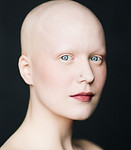
TYPES OF ALOPCIA

Alopecia Areata
Alopecia areata, the most common variation of the autoimmune disease, presents itself as round, smooth patches of various sizes.

Alopecia Totali
In this the scalp is affected and all the hair from the scalp is lost resulting in a smooth bald head.

Alopecia Areata Barbae
When alopecia affects the hair of the beard region, it is known as alopecia areata barbae.

Androgenetic Alopecia
Normal genetic hair loss caused by DHT in men and hereditary factors in women.

Ophiasis Type of Alopecia Areata
Shows a band like hair loss. It occurs mostly in the temporal or the occipital regions of the scalp and is therefore more difficult to treat, as most medicines have a delayed action on these areas. Ophiasis type of alopecia is identified by a turban or snake like pattern on the periphery of the scalp. Ophiasis in Greek means serpent and this is how the disease gets its name.

Perinevoid Alopecia Areata
This is a relatively unusual type of alopecia areata where spots of skin are found having properties different from the surrounding general skin area. Around these pigmented spots or nevi are found patches having characteristics of alopecia areata.

Alopecia Universalis
This is a severe form of Alopecia where there is loss of all body and scalp hair including eyebrows, eyelashes, underarms and pubic hair.

Traction Alopecia
This refers to hair loss which occurs do to traction or excessive rubbing on hair at the base of the scalp. Traction alopecia is commonly seen with braids, pony tails and other hairstyles which create traction on the scalp.
Reticulated Areata Barbae
In this form of disease, bald patches may not be found but there is hair loss in irregular patterns in a net like fashion. In the scalp, there are regions of hair loss interspersed with areas with normal hair growth. When affected with reticulated alopecia, patients may have hair falling from one region but new hair growth in another region. This phenomenon may for many months or years.